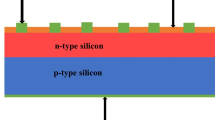Abstract
A generic model of a mid-infrared photodetector based on a narrow bandgap semiconductor has been developed. The model has been applied for analysis and simulation of an InAs0.89Sb0.11 photovoltaic detector for operation at room temperature in 2–5 μm wavelength region. The model takes into account the effect of tunneling and other components of dark current on the detectivity of the device by considering all the three dominant recombination mechanisms e.g., radiative, Shockley-Read-Hall and Auger recombination. The study revealed that the dark current of the photodetector under reverse bias is dominated by trap-assisted tunneling component of current and this causes the detectivity of the device to decrease at high reverse bias. It is further concluded that by operating the device at a suitable low reverse bias it is possible to improve the room-temperature detectivity significantly as compared to its value at zero bias.
Similar content being viewed by others
References
A. Rogalski, K. Adamiec, and J. Rutkowski, Narrow-Gap Semiconductor Photodiode, (SPIE, Bellingham, USA, 2000).
A. Rogalski, “New trends in semiconductor infrared detectors,” Opt. Eng. 33, 1395–1412 (1994).
A. Krier, H. H. Gao, and V. V. Sherstnev, “Room temperature InAs0.89 Sb0.11 photodetectors for CO detection at 4.6 μm,” Appl. Phys. Lett. 77(6), 872–874 (2000).
Y. Tian, B. Zhang, T. Zhan, H. Jiang, and Y. Jin, “Theoretical analysis of the detectivity in N-p and P-n GaSb/GaInAsSb infrared photo-detectors,” IEEE Trans. Electron Dev. ED-47, 544–551 (2000).
X. Y. Gong, T. Yamaguchi, H. Kan, T. Makino, T. Iida, T. Kato et al., M. Kumagawa, “Room temperature InAsxP1-x-y Sby/InAs photodetectors with large quantum efficiency,” Jpn. J. Appl. Phys. 36, 2614–2616 (1997).
P. Chakrabarti, A. Krier, and A. F. Morgan, “Analysis and simulation of a mid-infrared P+-InAs0.55Sb0.15P0.30/n0-InAs0.89Sb0.11/N+-InAs0.55Sb0.15P0.30 double heterojunction photodetector grown by LPE,” IEEE Trans. Electron Devices 50, (2003)
A. Rogalski, “Heterostructure infrared photovoltaic detectors,” Infrared Phys. Technol. 41, 213–238 (2000).
A. Rogalski, R. Ciupa, and W. Larkowski, “Near room temperature InAsSb photodiodes: theoretical predictions and experimental data,” Solid-state Electron. 39, 1593–1600 (1996).
N. T. Niedziela and R. Ciupa, “Ultimate parameters of Hg1xCdxTe and InAs1-x Sbx n+-p photodiodes,” Solid-state Electron. 45, 41–46 (2001).
D. Rosenfeld and G. Bahir, “A model for the trap assisted tunneling mechanism in diffused n-p and implanted n+-p HgCdTe photodiodes,” IEEE Trans. Electron Devices 39, 1638–1645 (1992).
M. Henini and M. Razeghi, Eds. Handbook of Infrared Detection Technologies, (Elsevier, New York, 2002).
B. F. Levine, “Quantum-well Infrared Photodetectors,” J. Appl. Phys. 74, R1–R81 (1993).
R. Schoolar, S. Price, and J. Rosbeck, “Investigation of the generation-recombination currents in HgCdTe midwavelength infrared photodiodes,” J.Vac. Sci. Technol. B 10, 1507–1514 (1992).
S. M. Sze, Physics of Semiconductor Devices, (Wiley Eastern, New Delhi, 1981).
M. Levinshtein, S. Rumyantsev, and M. Shur: “Hand book series on Semiconductor Parameters,” 1, World Scientific, (1996).
M. Levinshtein, S. Rumyantsev and M.S. Shur: “Hand book series on Semiconductor Parameters,” 2, World Scientific, (1996).
W. W. Anderson, “Absorption constant of Pb1x SnxTe and Hg1x CdxTe alloys,” Infrared Phys. 20, 363–372 (1980).
Author information
Authors and Affiliations
Corresponding author
Rights and permissions
About this article
Cite this article
Chakrabarti, P., Saxena, P.K. & Lal, R.K. Analytical Simulation of an InAsSb Photovoltaic Detector for Mid-Infrared Applications. Int J Infrared Milli Waves 27, 1119–1132 (2006). https://doi.org/10.1007/s10762-006-9093-8
Received:
Accepted:
Published:
Issue Date:
DOI: https://doi.org/10.1007/s10762-006-9093-8




